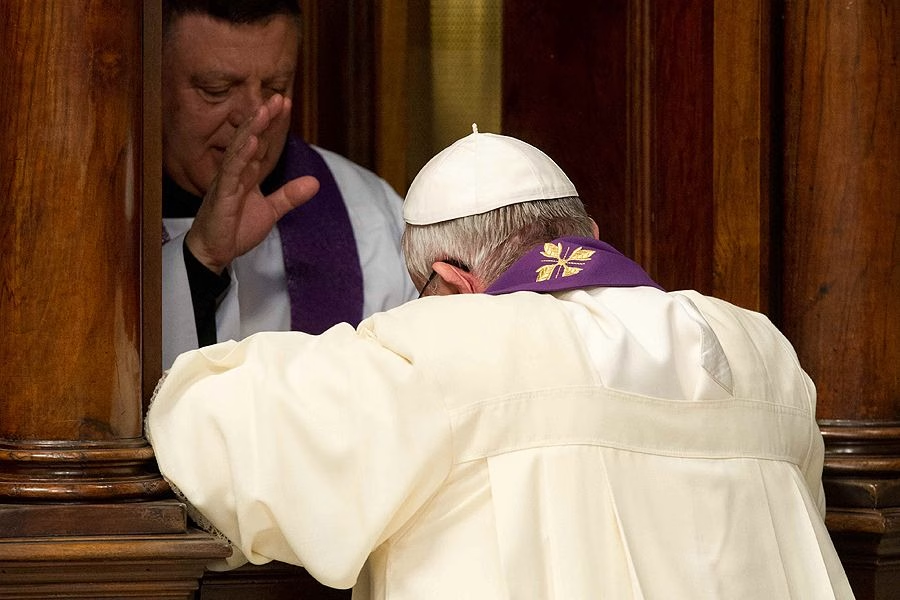The Sacrament of Reconciliation, also known as Confession or Penance, is one of the seven sacraments of the Catholic Church. It is a means by which Catholics seek forgiveness for their sins and reconcile with God and the Church community. Here are the key elements of this sacrament:
- Contrition: The penitent (the person confessing) must feel genuine sorrow for their sins and a firm resolution not to sin again.
- Confession: The penitent confesses their sins to a priest, who acts in the person of Christ (in persona Christi). This confession typically occurs in a confessional booth or a private setting.
- Absolution: After the penitent confesses their sins, the priest offers absolution, which is the formal forgiveness of sins. The priest says the words of absolution, which usually include the phrase, “I absolve you from your sins in the name of the Father, and of the Son, and of the Holy Spirit.”
- Penance: The priest assigns a penance to the penitent, which might include prayers, fasting, or acts of charity. This penance helps the penitent make amends for their sins and strengthen their spiritual life.
Certainly! Here’s a more detailed explanation of the Sacrament of Reconciliation:
Biblical Basis
The Sacrament of Reconciliation is rooted in Scripture. Jesus gave the apostles the authority to forgive sins in John 20:21-23, saying, “Receive the Holy Spirit. If you forgive the sins of any, they are forgiven; if you retain the sins of any, they are retained.”
Theological Significance
- Healing: The sacrament is seen as a means of spiritual healing. Sin is understood to harm not only one’s relationship with God but also the communal bond with the Church. Reconciliation restores both.
- Grace: Through this sacrament, Catholics believe they receive sanctifying grace, which strengthens them to resist sin and grow in holiness.
Steps in Detail
- Examination of Conscience: Before confession, the penitent reflects on their actions, thoughts, and omissions to identify sins. This involves prayerful consideration and self-examination.
- Contrition: True sorrow for sin is essential. There are two types of contrition:
- Perfect Contrition: Sorrow for sins out of love for God.
- Imperfect Contrition: Sorrow for sins out of fear of hell or consequences.
- Confession: The penitent confesses all mortal sins (serious sins) in kind and number. While confessing venial sins (less serious sins) is not mandatory, it is encouraged.
- Absolution: The priest, acting with the authority of Christ, pronounces the words of absolution. This act, along with the penitent’s contrition and confession, reconciles the person with God.
- Penance: The penance assigned can vary but is intended to help the penitent repair the damage caused by sin and grow in virtue.

you can also read more about the Sacrament of Reconciliation
Frequency and Practice
Catholics are encouraged to receive the Sacrament of Reconciliation regularly, with Church law requiring confession of mortal sins at least once a year. Many practice frequent confession, monthly or even weekly, to maintain spiritual health.
Benefits of the Sacrament
- Spiritual Guidance: During confession, the priest can offer spiritual counsel and guidance.
- Peace and Consolation: Receiving absolution provides a profound sense of peace and relief from guilt.
- Community Reconciliation: The sacrament also has a communal dimension, as it helps to heal the wounds that sin causes within the community.
Role of the Priest
The priest acts as a mediator between God and the penitent. He provides absolution, assigns penance, and offers spiritual guidance. The seal of confession binds the priest to absolute confidentiality regarding the sins confessed.
Historical Development
The practice of confession has evolved over centuries. Early Christians confessed sins publicly, but by the 7th century, private confession to a priest became the norm, influenced by monastic practices. you can also read about the blessed sacrament of the catholic church
Modern Practice
In contemporary Catholicism, Reconciliation services, especially during Advent and Lent, often include an examination of conscience, a communal act of contrition, and individual confession. The Sacrament of Reconciliation is a profound expression of God’s mercy and a vital practice for Catholics seeking to live a life of holiness and grace. The Sacrament of Reconciliation is seen as a vital practice for maintaining spiritual health, receiving God’s grace, and remaining in communion with the Church.




Leave a Reply